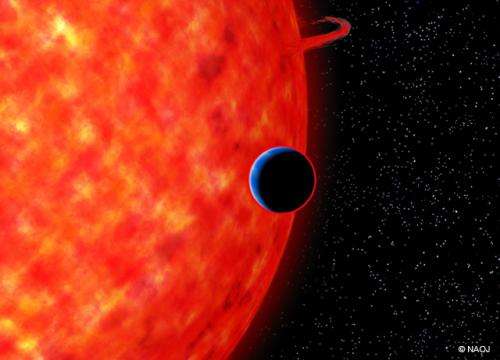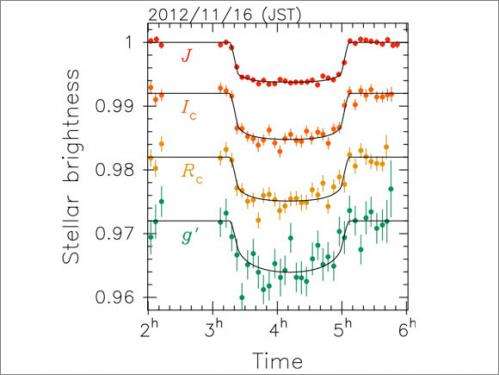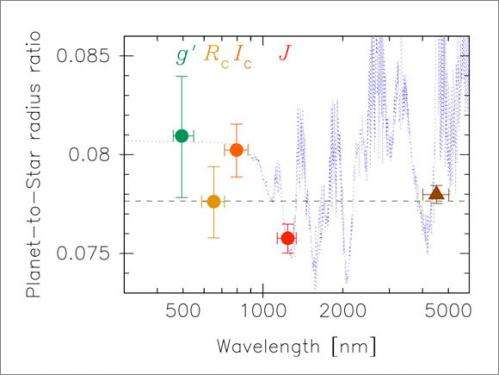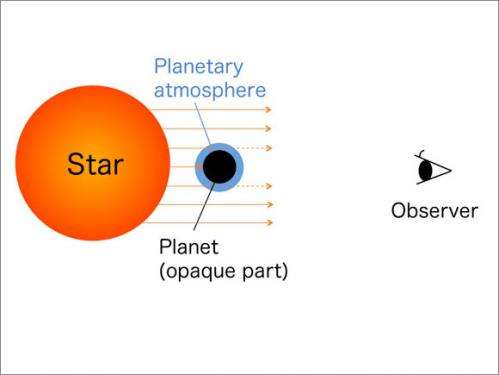Sunny super-Earth?

(Phys.org) —Researchers from NAOJ and the University of Tokyo have observed the atmosphere of super-Earth "GJ3470b" in Cancer for the first time in the world using two telescopes at OAO (Okayama Astrophysical Observatory, NAOJ). This super-Earth is an exoplanet, having only about 14 times the mass of our home planet, and it is the second lightest one among already-surveyed exoplanets. The observational data revealed that this planet is highly likely to NOT be covered by thick clouds.
The researchers expect that future detection of the specific composition of the planet's atmosphere based on highly accurate observations with larger aperture telescopes, such as the Subaru Telescope. This planet orbits around its primary star very closely at a rapid rate. We don't yet understand the formation process of such planets. If future detailed observations of the atmosphere detect any substance that becomes ice at low temperatures, it probably means that this planet was originally formed at a distance (a few astronomical units) from the primary star, where ice could exist, and moved toward the primary star thereafter. In contrast, if such a substance cannot be found in the atmosphere, this planet was quite likely formed at its present location (near the primary star) from its early stage. Thus, it is expected that the detailed observations of the atmosphere of GJ3470b can begin to reveal the mysteries behind the formation of super-Earths.
Details of results
It is very difficult to measure the radii of exoplenets, so in many cases we have information only about masses. However, if an exoplanet has a particular orbit of "Planetary Transit (Primary Transit)" where it passes in front of the primary star (parent star), we can estimate the radius of the planet. During the transit, the observed brightness of the star slightly drops depending on the size of the planet. So, we can estimate the radius of the planet by measuring the fading rate of light very precisely.

The research team performed highly accurate observations on the transit of exoplanet GJ3470b using the Near-Infrared Imager/Spectrograph (ISLE) camera mounted on the 188cm reflecting telescope and three visible light cameras on Multicolor Imaging Telescopes for Survey and Monstrous Explosions (MITSuME) telescope, all belonging to OAO, simultaneously. They measured the brightness dropping rates of the stars in 4 colors (from visible to near infrared). The observations enabled to estimate each radius by color for the planet (Figure 1). As a result, the radius derived from near infrared radiation (1.3 micrometer wavelength) is about 6% shorter than that from visible light. The difference of radii between colors probably is the reflection of the atmospheric characteristics of the planet. When the light from the primary star is transmitted through the thick atmosphere of the planet, certain wavelengths of light are absorbed or scattered by atmospheric molecules, which could cause the difference of apparent radii for each observation wavelength (Figure 2).
So far, the atmosphere of only two super-Earths including GJ3470b has been studied in detail. Estimation of the radius of an exoplanet is a very difficult task. Generally, the fading rate of the light from the star caused by the super-Earth's transit is extremely low. In the case of GJ3470b, however, the size of the primary star is small, so the planet-to-primary star size ratio is relatively large. Therefore, the fading rate of light from the primary star due to the transit becomes larger so it is measurably observable using ground-based telescopes with a medium size diameter.

The estimated radius of the planet by the near infrared radiation observations this time turns out to be about 4.3 times larger than that of the Earth. Moreover, theoretical calculations based on the mass and radius of the planet expected that the planet should have huge amount of atmosphere. Fukui commented, "Suppose the atmosphere consists of hydrogen and helium, the mass of the atmosphere would be 5 to 20% of the total mass of the planet. Comparing that to the fact that the mass of Earth's atmosphere is about one ten-thousandth of a percent (0.0001%) of the total mass of the Earth, this planet has a considerably thick atmosphere."
Because differences in radii by colors were found in this observation, it is safe to say that thick clouds do not cover GJ3470b. If thick clouds covered the planet, no differences in radii by color should exist.

The research team plans to conduct observations of even higher accuracy using the Subaru Telescope or other large telescopes. "GJ3470b's orbit of its primary star is very close, at just 0.036 AU (astronomical units), which is about 28 times less than the distance between the Sun and the Earth, and revolves in a short cycle of only 3.3 days. Scientists still don't understand well how such a planet was formed. GJ3470b is really possibly not covered by thick clouds, so we believe the composition of the planet's atmosphere could be detected without being blocked by its clouds. If we find any substance, such as water or methane, which becomes ice at low temperatures, it probably means that this planet was originally formed at a distance (a few astronomical units) from the primary star, where ice could exist, and moved toward the primary star thereafter. In contrast, if such substance cannot be found in the atmosphere, it can be thought to be quite likely that this planet was formed near the primary star. We expect to obtain important clues for figuring out how super-Earths were formed through observations of the atmospheric component of GJ3470b," said Fukui.
The frequently sunny weather in Okayama Prefecture was in our favor in obtaining the observation results. A continuously clear sky over several hours through an expected transit time is crucial to precisely measure the radius of an exoplanet. So it can be said that the "Sunny District" Okayama brought on this finding of the "sunny super-Earth". The researchers will continue observations with the telescopes at OAO, hoping to lead to further progress.
The article is titled "Optical-to-near-infrared simultaneous observations for the hot Uranus gj3470b: A hint of a cloud-free atmosphere," and is published in Astrophysical Journal (2013 June 20).
More information: Paper: iopscience.iop.org/0004-637X/770/2/95
Journal information: Astrophysical Journal
Provided by National Astronomical Observatory of Japan



















